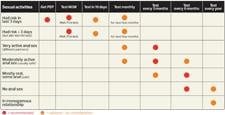Most of us hate tests.Some of us thought the end of school meant the end of tests. But gay guys know better.
Gay guys face the prospect of additional tests for life — or at least until a positive one shows up. Either way, they’re not much fun.
Still, most of us should get tested regularly.
How regularly? Have a look at the matrix I created. It’s not intended to address all aspects of a gay man’s complex sexual life. It is only my suggestion for developing a testing strategy based on individual risk activities, rather than poorly defined window periods.
For more than a decade, there was some unhelpful advice that we should wait six months after a risk to get tested. The theory was it took six months for evidence of the virus to show up, and therefore six months to be sure a negative test was truly negative.
Now we know that testing three months after a risk, using the conventional antibodies test, yields a result that’s more than 99 percent accurate.
And now there’s an even quicker test available in some locations in BC.
No more waiting even three months for an accurate HIV result. The new early-detection test (called the NAAT test) can identify the presence of HIV in the body less than two weeks after possible exposure. The Health Initiative for Men is one of several clinics in Vancouver running a trial on this test.
We, as gay guys, have been the largest group of people testing positive for the last few years, so we need better information and guidelines on when to get tested. The BC Centre for Disease Control and other public health agencies should work harder to inform gay guys about testing.
In the meantime, I have made this general guide for gay guys. My theory: the greater the likelihood of testing positive, the more frequently we should get tested.
Open Wide appears in every other issue of Xtra.

 Why you can trust Xtra
Why you can trust Xtra


